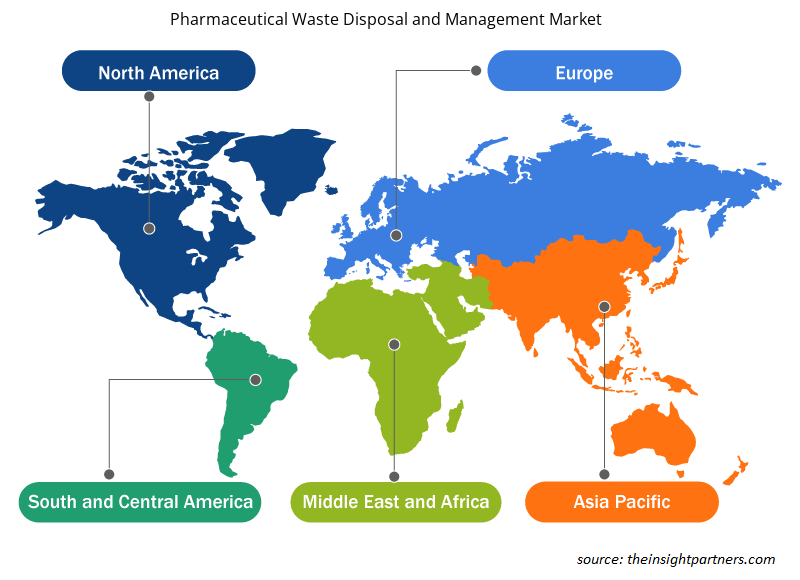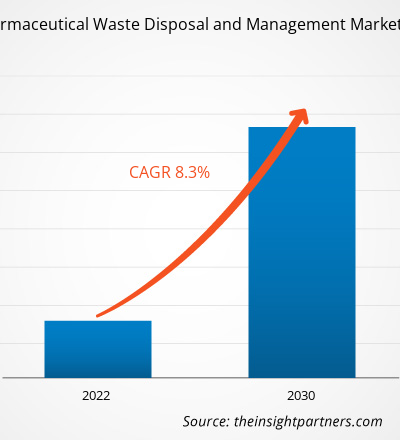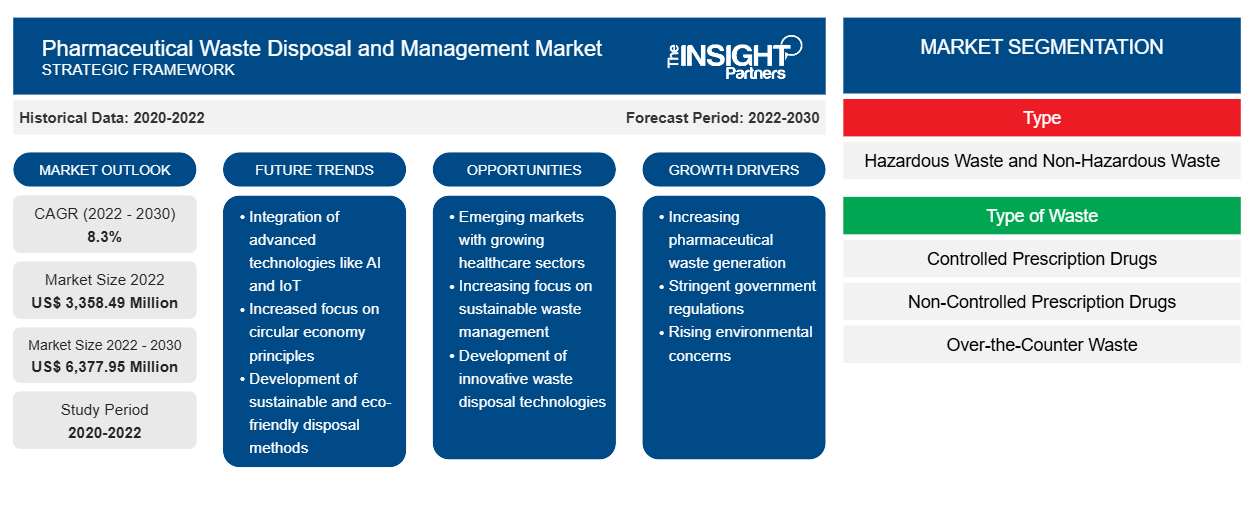[Rapporto di ricerca] Si prevede che il mercato dello smaltimento e della gestione dei rifiuti farmaceutici crescerà da 3.358,49 milioni di dollari nel 2022 a 6.377,95 milioni di dollari entro il 2030; si prevede che registrerà un CAGR dell'8,3% dal 2022 al 2030.CAGR of 8.3% from 2022 to 2030.
Approfondimenti di mercato e opinioni degli analisti:
I rifiuti farmaceutici includono prodotti inutilizzati o farmaci che hanno superato la data di scadenza. Questi rifiuti possono essere classificati come pericolosi o non pericolosi in base alla loro composizione chimica. La classificazione dei medicinali in rifiuti farmaceutici si basa anche sul fatto che rappresentino un rischio per la salute pubblica o per l'ambiente. I rifiuti farmaceutici includono anche materiali rimanenti dai loro processi di produzione e farmaci da banco, oltre ai farmaci da prescrizione rimasti per i motivi sopra menzionati. I fattori chiave che guidano la crescita del mercato dello smaltimento e della gestione dei rifiuti farmaceutici includono l'aumento delle iniziative governative per promuovere il corretto smaltimento dei rifiuti medici e una maggiore consapevolezza riguardo ai rifiuti farmaceutici. Tuttavia, l'elevato costo associato allo smaltimento dei rifiuti farmaceutici ostacola la crescita del mercato.
Fattori trainanti e limiti della crescita:
Grandi volumi di rifiuti vengono prodotti da ospedali, cliniche e altre istituzioni sanitarie. Gli sforzi governativi focalizzati sulla facilitazione dello smaltimento appropriato dei rifiuti medici sono aumentati in modo significativo negli ultimi anni, poiché una gestione e uno smaltimento inappropriati rappresentano un rischio crescente per la salute umana e l'ambiente. L'espansione delle strutture sanitarie e un aumento della produzione di rifiuti medici sono due fattori principali che contribuiscono all'aumento della domanda di prodotti e servizi per lo smaltimento e la gestione dei rifiuti medici. Diversi governi hanno adottato misure per controllare i problemi associati ai rifiuti medici emanando leggi e politiche che garantiscono uno smaltimento sicuro e appropriato dei rifiuti medici. I rifiuti medici in genere devono essere smaltiti correttamente e imballati, trasportati, trattati e separati secondo queste regole. Negli Stati Uniti, agenzie come i Centers for Disease Control and Prevention (CDC), l'Occupational Safety and Health Administration (OSHA) e la US Food and Drug Administration (FDA) hanno elaborato normative sui rifiuti medici. Il titolo 49 CFR è una normativa federale focalizzata sulle normative sui rifiuti medici, sui processi di raccolta e smaltimento e il 49 CFR 173.197 si concentra sui rifiuti medici regolamentati. CFR is a federal regulation focused on medical waste regulations, collection, and disposal processes and 49 CFR 173.197 focuses on regulated medical waste.
D'altro canto, l'elevato costo del processo di smaltimento complessivo è una preoccupazione fondamentale per le aziende di smaltimento e gestione dei rifiuti farmaceutici, che colpisce i venditori farmaceutici, le strutture sanitarie e i fornitori di servizi di gestione dei rifiuti. Costi elevati sono associati a ogni fase del processo di smaltimento, tra cui imballaggio appropriato dei rifiuti, segregazione, trasporto, trattamento, scartoffie e conformità. Inoltre, gli elevati costi dello smaltimento dei rifiuti farmaceutici sono dovuti all'implementazione di protocolli specializzati, alla conformità normativa e alla necessità di tecniche di gestione dei rifiuti sostenibili ed etiche.
Personalizza questo report in base alle tue esigenze
Riceverai la personalizzazione gratuita di qualsiasi report, comprese parti di questo report, o analisi a livello nazionale, pacchetto dati Excel, oltre a usufruire di grandi offerte e sconti per start-up e università
-
Scopri le principali tendenze di mercato in questo rapporto.Questo campione GRATUITO includerà analisi di dati che spaziano dalle tendenze di mercato alle stime e alle previsioni.
Segmentazione e ambito del report:
Il mercato globale dello smaltimento e della gestione dei rifiuti farmaceutici è segmentato in base al tipo, al tipo di rifiuto e all'applicazione. In base al tipo, il mercato dello smaltimento e della gestione dei rifiuti farmaceutici è suddiviso in rifiuti pericolosi e rifiuti non pericolosi. In base al tipo di rifiuto, il mercato dello smaltimento e della gestione dei rifiuti farmaceutici è differenziato in farmaci da prescrizione controllati, farmaci da prescrizione non controllati e rifiuti da banco. In base all'applicazione, il mercato è segmentato in strutture sanitarie, farmacie, aziende farmaceutiche e biotecnologiche e altri. Il mercato dello smaltimento e della gestione dei rifiuti farmaceutici, in base alla geografia, è segmentato in Nord America (Stati Uniti, Canada e Messico), Europa (Germania, Francia, Italia, Regno Unito, Russia e resto d'Europa), Asia Pacifico (Australia, Cina, Giappone, India, Corea del Sud e resto dell'Asia Pacifico), Medio Oriente e Africa (Sudafrica, Arabia Saudita, Emirati Arabi Uniti e resto del Medio Oriente e Africa) e Sud e Centro America (Brasile, Argentina e resto del Sud e Centro America).
Analisi segmentale:
Il mercato dello smaltimento e della gestione dei rifiuti farmaceutici, per tipo, è diviso in rifiuti pericolosi e rifiuti non pericolosi. Il segmento dei rifiuti non pericolosi ha detenuto una quota di mercato maggiore nel 2022. Tuttavia, si prevede che il segmento dei rifiuti pericolosi registrerà un CAGR più elevato nel periodo 2022-2030.
Il mercato dello smaltimento e della gestione dei rifiuti farmaceutici, per tipo di rifiuto, è suddiviso in farmaci da prescrizione controllati, farmaci da prescrizione non controllati e rifiuti da banco. Il segmento dei farmaci da prescrizione non controllati ha detenuto la quota di mercato maggiore nel 2022. Si prevede che registrerà il CAGR più elevato dal 2022 al 2030.
Il mercato dello smaltimento e della gestione dei rifiuti farmaceutici, per applicazione, è segmentato in strutture sanitarie, farmacie, aziende farmaceutiche e biotecnologiche e altri. Nel 2022, il segmento delle aziende farmaceutiche e biotecnologiche ha detenuto la quota di mercato maggiore. Si prevede che il segmento registrerà il CAGR più elevato nel periodo 2022-2030. CAGR during 2022–2030.
Analisi regionale:
In base alla geografia, il mercato globale dello smaltimento e della gestione dei rifiuti farmaceutici è suddiviso in cinque regioni chiave: Nord America, Europa, Asia Pacifico, Sud e Centro America, Medio Oriente e Africa.Nel 2022, il Nord America deteneva la quota maggiore del mercato. Il mercato in Nord America riflette un panorama complesso guidato da normative severe, tecnologie avanzate di gestione dei rifiuti e un impegno per la tutela ambientale. Legislazioni come l'US Resource Conservation and Recovery Act (RCRA) e il Canadian Environmental Protection Act (CEPA) implementano i protocolli obbligatori per la gestione e lo smaltimento sicuri dei rifiuti farmaceutici, seguiti dal monitoraggio dell'aderenza agli stessi, il che favorisce la crescita del mercato dello smaltimento e della gestione dei rifiuti farmaceutici.RCRA) and the Canadian Environmental Protection Act (CEPA) roll out the mandatory protocols for the safe handling and disposal of pharmaceutical waste, followed by monitoring adherence to the same, which benefits the pharmaceutical waste disposal and management market growth.
Sviluppi del settore e opportunità future:
Di seguito sono elencate le varie iniziative intraprese dai principali attori che operano nel mercato globale dello smaltimento e della gestione dei rifiuti farmaceutici:
- Nel novembre 2023, Sumitomo Pharma Co., Ltd. ha accettato di collaborare con ORIX Eco Services Corporation nell'ambito di un'iniziativa volta a riciclare i rifiuti di blister generati nel processo di confezionamento dei farmaci da prescrizione prodotti da Sumitomo Pharma.
- Nel maggio 2023, ORIX Eco Services è diventata la prima azienda in Giappone a ottenere una licenza per lo smaltimento di rifiuti industriali per lo stripping di imballaggi blister e altri materiali. L'imballaggio blister viene effettuato per il confezionamento di farmaci da prescrizione e i rifiuti generati tramite questo metodo sono stati precedentemente inceneriti.
- Ad aprile 2022, Stericycle Inc ha annunciato la sua nuova linea SafeShield di contenitori standardizzati di alta qualità. Questi contenitori antimicrobici per rifiuti medici sono specificamente progettati per immagazzinare e trasportare rifiuti medici regolamentati (RMW). Questi contenitori offrono ai clienti migliori opzioni di stoccaggio, un design migliorato e un livello di protezione aggiuntivo per prevenire la crescita microbica sui contenitori RMW. Stericycle aveva precedentemente iniziato a distribuire i contenitori in mercati selezionati negli Stati Uniti dopo aver pianificato un lancio nazionale graduale.
- Nel febbraio 2022, Republic Services Inc ha acquisito US Ecology per espandere la propria presenza negli Stati Uniti e in Canada. US Ecology è un fornitore leader di soluzioni ambientali per il trattamento, il riciclaggio e lo smaltimento di rifiuti pericolosi, non pericolosi e speciali.
- Nell'ottobre 2020, Waste Management Inc ha acquisito Advanced Disposal per espandere la propria portata. Inoltre, Waste Management ha pianificato di utilizzare la capacità di Advanced Disposal per soddisfare circa 3 milioni di nuovi clienti commerciali, industriali e residenziali negli Stati Uniti.
Approfondimenti regionali sul mercato dello smaltimento e della gestione dei rifiuti farmaceutici
Le tendenze regionali e i fattori che influenzano il Pharmaceutical Waste Disposal and Management Market durante il periodo di previsione sono stati ampiamente spiegati dagli analisti di Insight Partners. Questa sezione discute anche i segmenti di Pharmaceutical Waste Disposal and Management Market e la geografia in Nord America, Europa, Asia Pacifico, Medio Oriente e Africa e Sud e Centro America.

- Ottieni i dati specifici regionali per il mercato dello smaltimento e della gestione dei rifiuti farmaceutici
Ambito del rapporto di mercato sullo smaltimento e la gestione dei rifiuti farmaceutici
| Attributo del report | Dettagli |
|---|---|
| Dimensioni del mercato nel 2022 | 3.358,49 milioni di dollari USA |
| Dimensioni del mercato entro il 2030 | 6.377,95 milioni di dollari USA |
| CAGR globale (2022-2030) | 8,3% |
| Dati storici | 2020-2022 |
| Periodo di previsione | 2022-2030 |
| Segmenti coperti |
Per tipo
|
| Regioni e Paesi coperti |
America del Nord
|
| Leader di mercato e profili aziendali chiave |
|
Densità degli attori del mercato dello smaltimento e della gestione dei rifiuti farmaceutici: comprendere il suo impatto sulle dinamiche aziendali
Il mercato dello smaltimento e della gestione dei rifiuti farmaceutici sta crescendo rapidamente, spinto dalla crescente domanda degli utenti finali dovuta a fattori quali l'evoluzione delle preferenze dei consumatori, i progressi tecnologici e una maggiore consapevolezza dei benefici del prodotto. Con l'aumento della domanda, le aziende stanno ampliando le loro offerte, innovando per soddisfare le esigenze dei consumatori e capitalizzando sulle tendenze emergenti, il che alimenta ulteriormente la crescita del mercato.
La densità degli operatori di mercato si riferisce alla distribuzione di aziende o società che operano in un particolare mercato o settore. Indica quanti concorrenti (operatori di mercato) sono presenti in un dato spazio di mercato in relazione alle sue dimensioni o al valore di mercato totale.
Le principali aziende che operano nel mercato dello smaltimento e della gestione dei rifiuti farmaceutici sono:
- Stericycle, Inc.
- Porti puliti, Inc.
- WM Holdings di proprietà intellettuale, LLC
- Veolia
- Soluzioni per rifiuti biomedici, LLC.
Disclaimer : le aziende elencate sopra non sono classificate secondo un ordine particolare.

- Ottieni una panoramica dei principali attori del mercato dello smaltimento e della gestione dei rifiuti farmaceutici
Scenario competitivo e aziende chiave:
Stericycle Inc, Clean Harbors Inc, WM Intellectual Property Holdings LLC, Veolia, BioMedical Waste Solutions LLC, Daniels Sharpsmart Inc, US Ecology Inc, Stryker, Cardinal Health e MedWaste Management sono tra i principali attori che operano nel mercato dello smaltimento e della gestione dei rifiuti farmaceutici. Queste aziende si concentrano sullo sviluppo di prodotti esistenti e sull'espansione della loro presenza geografica per soddisfare la crescente domanda dei consumatori in tutto il mondo.
- Analisi storica (2 anni), anno base, previsione (7 anni) con CAGR
- Analisi PEST e SWOT
- Valore/volume delle dimensioni del mercato - Globale, Regionale, Nazionale
- Industria e panorama competitivo
- Set di dati Excel
Report recenti
Rapporti correlati
Testimonianze
Motivo dell'acquisto
- Processo decisionale informato
- Comprensione delle dinamiche di mercato
- Analisi competitiva
- Analisi dei clienti
- Previsioni di mercato
- Mitigazione del rischio
- Pianificazione strategica
- Giustificazione degli investimenti
- Identificazione dei mercati emergenti
- Miglioramento delle strategie di marketing
- Aumento dell'efficienza operativa
- Allineamento alle tendenze normative























 Ottieni un campione gratuito per - Mercato dello smaltimento e della gestione dei rifiuti farmaceutici
Ottieni un campione gratuito per - Mercato dello smaltimento e della gestione dei rifiuti farmaceutici